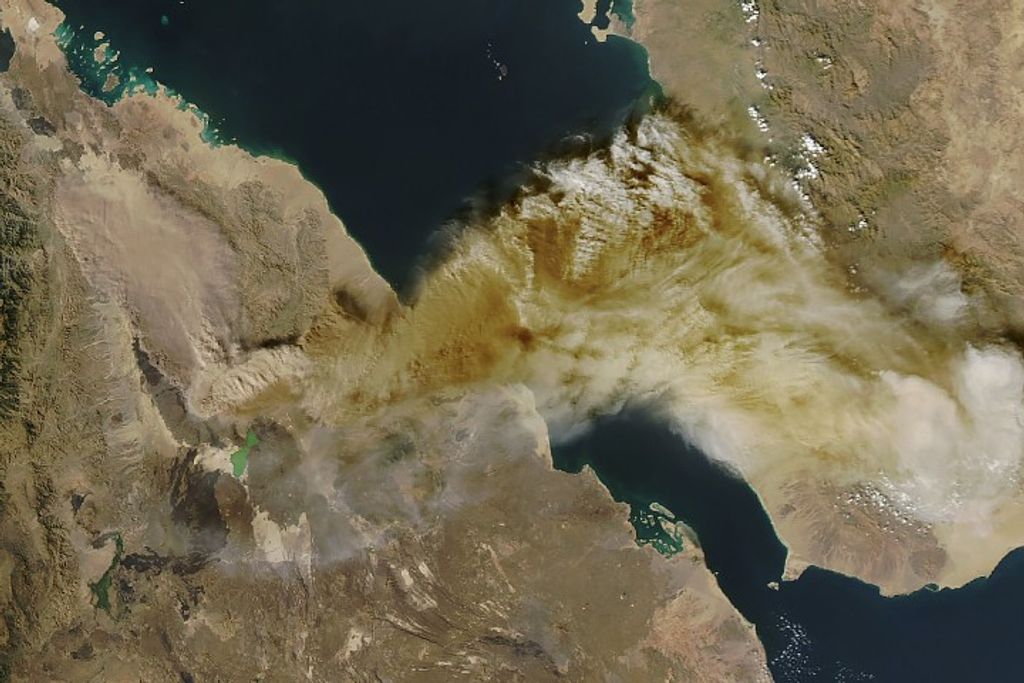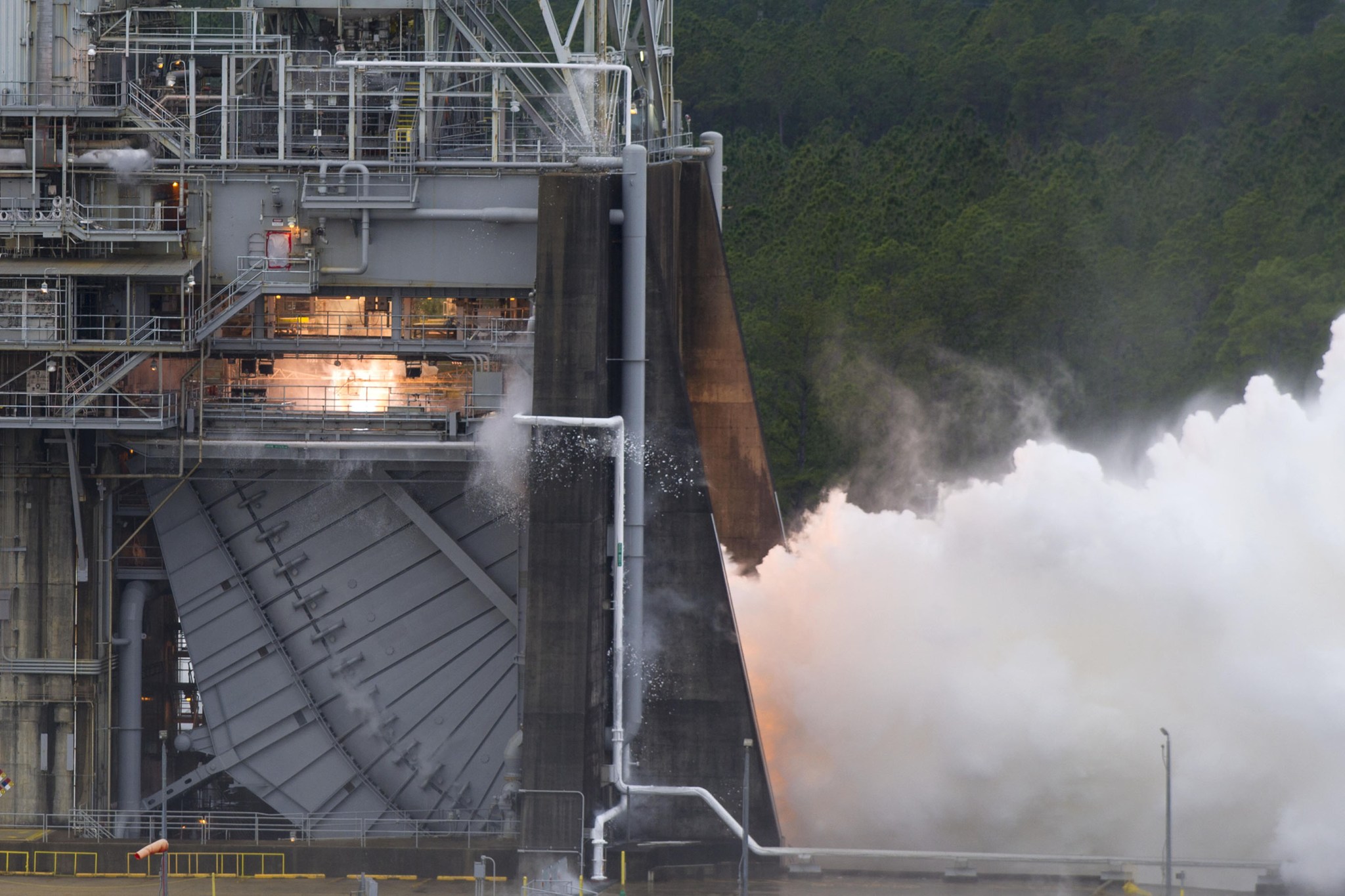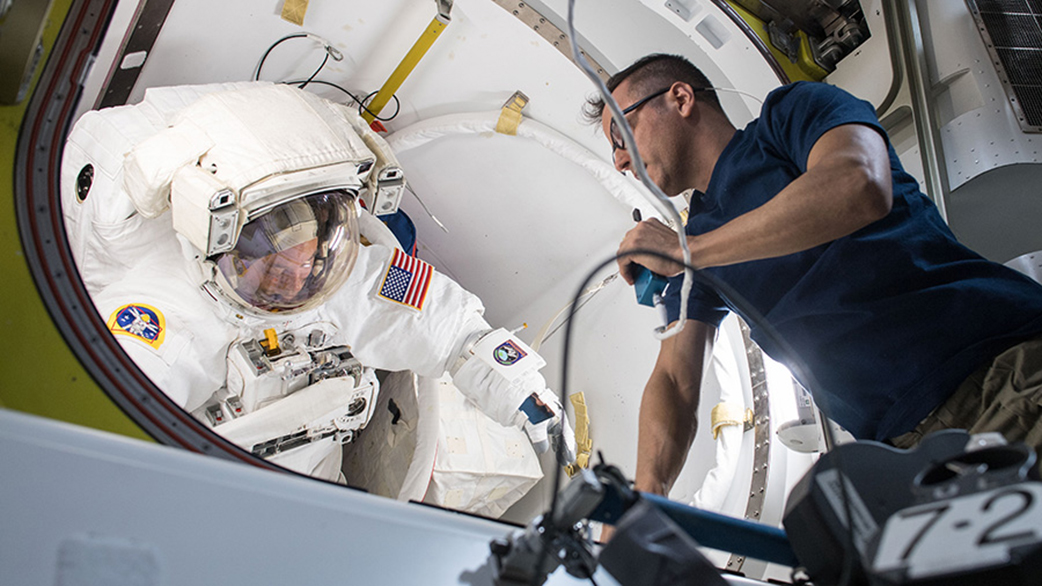In This Week’s Star
- NASA Picks Up Where It Left Off in 2017, Tests RS-25 Flight Controller
- NASA Astronauts Wrap Up First Spacewalk of 2018
- Marshall to Hold Day of Remembrance Ceremonies Jan. 25
- Marshall Volunteers Join Surge Capacity Force to Help with Natural Disaster Relief
- Former Glenn Associate Director Bill Wessel Addresses Marshall ‘Shared Experiences’ Forum Audience Jan. 19
- This Week in NASA History: Apollo 5 Launches – Jan. 22, 1968
- Obituaries
NASA Picks Up Where It Left Off in 2017, Tests RS-25 Flight Controller
NASA engineers picked up this year where they left off in 2017, conducting a certification test of another RS-25 engine flight controller Jan. 16 on the A-1 Test Stand at Stennis Space Center. The 365-second, full-duration test came a month after the space agency capped a year of RS-25 testing with a flight controller test in mid-December.
A 3D-printed part tested in December was tested again. This rocket engine component, a pogo accumulator assembly, is part of an ongoing series of tests with parts made using advanced manufacturing techniques that will make building future engines more affordable.
For this “green run” test, the flight controller was installed on RS-25 developmental engine E0528 and fired just as it will during an actual launch. Once certified, the flight controller will be removed and installed on a flight engine for use by NASA’s new deep-space rocket, the Space Launch System. NASA is building SLS as the most powerful rocket in the world, designed to carry humans on the Orion spacecraft and enable missions to the Moon and Mars.
Launch of the SLS rocket will be fueled by four RS-25 engines firing simultaneously to generate 2 million pounds of thrust and working in conjunction with a pair of solid rocket boosters to produce more than 8 million pounds of thrust.
RS-25 engines for the initial SLS flights are former space shuttle main engines, modified to provide the additional power needed by the larger SLS rocket. A key part of that modification is the new flight controller, which works as the RS-25 “brain,” helping the engine communicate with the SLS rocket and providing precision control of engine operation and internal health diagnostics. NASA is testing all RS-25 engines and flight controllers at Stennis for SLS missions.
The initial flight of SLS, Exploration Mission-1, will serve as the first test flight for the new rocket and will carry an uncrewed Orion spacecraft. All the engines for this flight have been tested at Stennis and are ready to be attached to the rocket’s core stage being built at NASA’s Michoud Assembly Center. Current engine tests are for controllers for Exploration Mission-2, the first flight that will transport astronauts aboard Orion.
In addition to the engine tests at Stennis, NASA is preparing the B-2 Test Stand at the center to test the entire SLS core stage with its four engines for EM-1. This “green run” testing will involve installing the flight core stage on the B-2 stand and firing all four RS-25 engines simultaneously, just as during an actual launch. RS-25 tests at Stennis are conducted by a team of NASA, Aerojet Rocketdyne and Syncom Space Services engineers and operators. Aerojet Rocketdyne is the RS-25 prime contractor. Syncom Space Services is the prime contractor for Stennis facilities and operations.
NASA Astronauts Wrap Up First Spacewalk of 2018
Expedition 54 Flight Engineers Mark Vande Hei and Scott Tingle of NASA completed the first spacewalk of 2018 at 1:13 p.m. CST, Jan. 23, lasting 7 hours, 24 minutes. The two astronauts replaced a Latching End Effector on the International Space Station’s robotic arm, Canadarm2. There are two redundant end effectors on each end of the arm used to grapple visiting vehicles and components during a variety of operational activities. The spacewalk was the 206th in support of space station assembly and maintenance, the third in Vande Hei’s career and the first for Tingle. Here, NASA astronaut Joe Acaba, left, assists Tingle during a fit check in his U.S. spacesuit. Vande Hei will venture outside the station again Jan. 29 with Flight Engineer Norishige Kanai of the Japan Aerospace Exploration Agency to stow a spare latching end effector removed from the robotic arm in October 2017. Spacewalkers have now spent a total of 53 days, 13 hours, and 49 minutes working outside the station in support of assembly and maintenance of the orbiting laboratory. For more information about the station, visit https://www.nasa.gov/station. (NASA)
Marshall to Hold Day of Remembrance Ceremonies Jan. 25
NASA’s Marshall Space Flight Center will pay tribute to the crews of Apollo 1 and space shuttles Challenger and Columbia, as well as other NASA colleagues, during the agency’s Day of Remembrance on Jan. 25.
NASA’s Day of Remembrance honors members of the NASA family who lost their lives while furthering the cause of exploration and discovery. This year, NASA pays special remembrance to the crew of Columbia on the 15th anniversary of the accident.
Employees are invited to join Marshall Director Todd May, former astronaut and retired Army Brig. Gen. Robert Stewart and other Marshall officials for a candle-lighting observance at 9 a.m. Jan. 25, in the lobby of Building 4200.
The agency also is paying tribute to its fallen astronauts with special online content at:
Marshall Volunteers Join Surge Capacity Force to Help with Natural Disaster Relief
By Joel Wallace
Three major hurricanes, combined with devastating wildfires, made 2017 the costliest year on record for disasters in the United States. To assist in hurricane and wildfire response, NASA’s Marshall Space Flight Center is not just using satellites and technology, but also provided “boots on the ground” in the Surge Capacity Force to help these communities recover.
Organized by the U.S. Department of Homeland Security, the Surge Capacity Force is made up of federal employees from every department and agency in the federal government. The cadre of federal employee “heroes” helps affected communities by supporting the Federal Emergency Management Agency’s urgent response and recovery efforts after disasters strike.
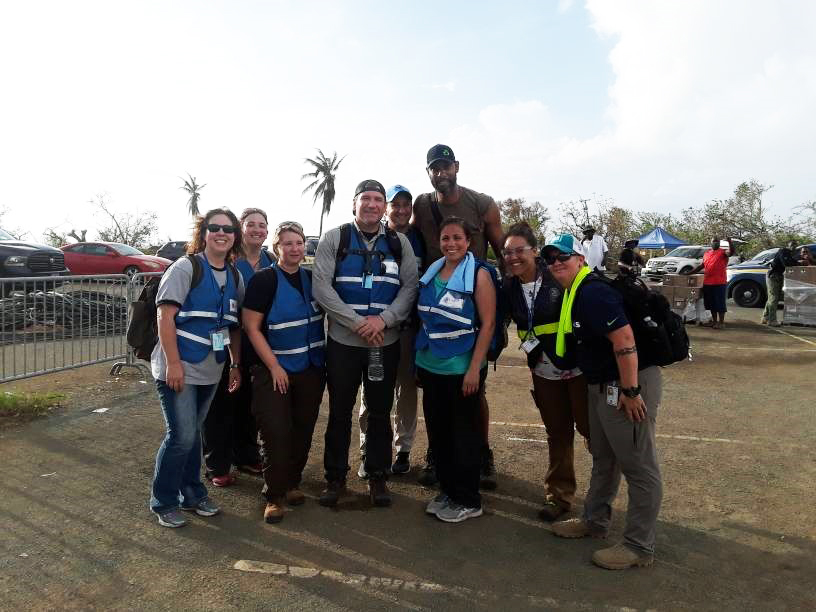
“Marshall team members are the kind of people who seek to make a positive difference in the lives of others,” said Larry Mack, deputy director of the Office of Human Capital at Marshall. “When devastation from natural disasters strike, the Marshall workforce quickly responds by volunteering. But it takes the entire Marshall team to make volunteerism work — from managers redirecting the normal work of those who volunteer, to those employees who willingly take on additional duties to allow their co-workers to help those in need.”
Twenty-one Marshall employees volunteered to participate in the Surge Capacity Force. Team members, deployed in waves, were first sent to Anniston, Alabama, for training before transitioning to the disaster location they were assigned.
The eternal optimism of the victims was something that Jodi Lemley, a Force volunteer who works as an integration analyst in the Science and Technology Office’s Programming Planning and Control Office at Marshall, found encouraging. “My husband, a member of the National Guard, found out what it’s like to be left with the kids,” Lemley said, laughing. “It was outside my normal swim lane. I saw it as a challenge and a way to help people.”
Nancy May, administrative officer for the Science and Technology Office, served as a disaster survivor assistant in Saint Thomas, an island in the Caribbean Sea. Seeing the devastation while working from the pipe-laying vessel, Ocean Constructor, reminded May of the things she appreciates. “We take a lot for granted sometimes,” she said, “Just being able to help one family was worth the effort.”
As a recipient of FEMA support during Hurricane Katrina, Jon Street, Material and Welding Branch chief at Marshall, had experienced the other side. “I immediately wanted to volunteer and give back,” said Street. “I was proud to work for Marshall because our leadership, my supervisors and travel assistants were all very supportive of what we were trying to accomplish.”
Surge Capacity Force was created out of the Post-Katrina Emergency Management Reform Act of 2006, which ordered the Department of Homeland Security to designate additional employees who could create a backup team to be called on to help with major natural disasters. Surge Capacity Force was first called into action after Hurricane Sandy hit New Jersey in 2012.
On July 31, 2017, Surge Capacity Force was called on again and expanded — for the first time — to all federal agencies. With Hurricanes Harvey, Irma and Maria making landfall within weeks of each other, coupled with multiple wildfires in California, FEMA needed assistance. Deployments lasted for an average of 45 days.
“My heartfelt thanks go out to all of the individuals who volunteered or assisted during this important recovery effort,” Mack said. “Their service demonstrates the strength and selflessness of the Marshall Space Flight Center community.”
Former Glenn Associate Director Bill Wessel Addresses Marshall ‘Shared Experiences’ Forum Audience Jan. 19
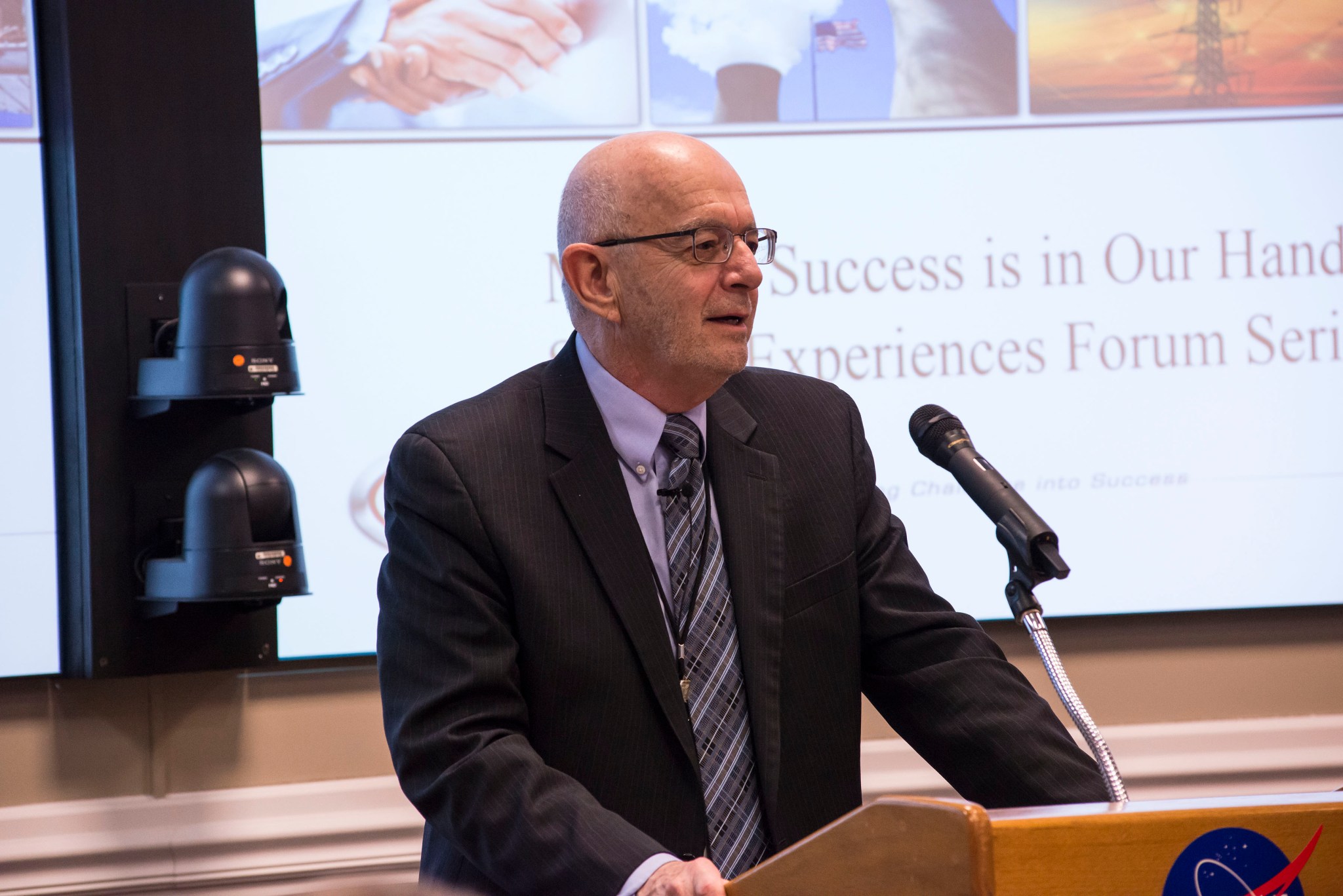
Vernon “Bill” Wessel, former associate director of NASA’s Glenn Research Center from 2006-2011, addresses team members at NASA’s Marshall Space Flight Center Jan. 19 as part of the “Mission Success in in Our Hands” Shared Experiences forum. Wessel, currently senior vice president of Ares Corp. and deputy of the Huntsville-based company’s Space & Defense Division, spoke about his 30-year NASA career and the importance of workplace safety. “Keep in your head every day and in every way that safety is number one,” he said. “When you meet people, ask them, ‘How are you doing today? How’s the job? How are you staying safe?’ These are the things that are important.” The bimonthly Shared Experiences forum, a Marshall safety initiative to promote and strengthen mission assurance and flight safety, is sponsored by NASA partner Jacobs Engineering of Huntsville. (NASA/MSFC/Fred Deaton)
This Week in NASA History: Apollo 5 Launches – Jan. 22, 1968

This week in 1968, Apollo 5 launched from NASA’s Kennedy Space Center. The primary mission objectives, including the verification of the Apollo Lunar Module ascent and descent propulsion systems and the evaluation of the S-IVB stage instrument performance, were successfully met. The S-IVB — which served as the second stage on Apollo 5’s launch vehicle, the Saturn IB — was managed by the NASA’s Marshall Space Flight Center. Today, Marshall is developing NASA’s Space Launch System, the most powerful rocket ever built, capable of sending astronauts to the Moon, Mars and deeper into space than ever before. The NASA History Program is responsible for generating, disseminating and preserving NASA’s remarkable history and providing a comprehensive understanding of the institutional, cultural, social, political, economic, technological and scientific aspects of NASA’s activities in aeronautics and space. For more pictures like this one and to connect to NASA’s history, visit the Marshall History Program’s webpage. (NASA)
Obituaries
Henry B. Waites, 76, of Huntsville, died Jan. 19. He retired from the Marshall Center in 1999 as an aerospace engineer. He is survived by his wife, Nancy K. Waites.
Leon J. Hastings, 78, of Fairhope, Alabama, died Jan. 4. He retired from the Marshall Center in 2001 as an engineer.









